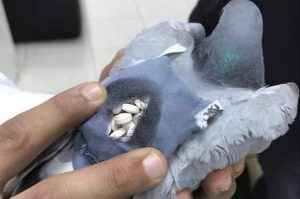Pigeons are significant in Iranian culture and poetry. Pigeon racing was a popular tradition, and some
in rural areas and smaller cities still participate in the sport, holding vast numbers of pigeons on rooftops or in their garden.
In May, officials in Kuwait said they had seized a pigeon carrying 178 illicit pills in a tiny backpack. Images carried by the Kuwaiti
newspaper al-Rai showed a pigeon with a miniature fabric backpack attached to its back, full of pills containing ketamine.
That incident took place in the city of Abdali, near the border with Iraq.And in 2011, Colombian police discovered a pigeon
that was unable to fly over a high prison wall because of the weight of a package of cocaine and marijuana strapped to it.
They have been used to carry messages since Roman times, using their powerful “homing” ability.
One Pigeons can carry £2,500 worth of drugs
Since cocaine has a rough street value of about £50 per gram, that means one pigeon can potentially carry up to £2,500 of drugs.
Generally when birds are used as drug mules the contraband is strapped to them rather than inside them, which is less risky for
the birds and means they can carry more weight.

Racing pigeons can return to their lofts from distances of hundreds of kilometres.
This is not an isolated incident. Pigeons have used around the world to smuggle high-value, light-weight illegal narcotics
into prisons and across borders. Pigeons have caught in Costa Rica, Columbia, and the United States.
Inmates at a Brazilian prison in Marilia, Sao Paulo state created a pigeon pen in the roof of the jail in order to smuggle mobile
phones and drugs into the prison. Prisoners would smuggle the birds out through friends and family, who would attach drugs to
the backs of the birds in a small pouch.











